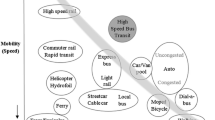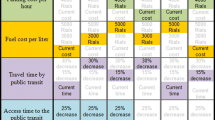Abstract
Researchers have been seeking approaches to persuade car users to shift to mass transit through implementing transit priority strategies. Widely used transit priority strategies include a Managed Bus Lane (MBL), transit fare discount, and an increase in parking fees. Most previous studies have focused on the implementation of a single priority strategy, which may not be sufficient enough to induce a significant shift in travel mode. This study aims to investigate the effect of multiple transit priority strategies, also known as multi-strategy, on the travel modal shift of car users. For this purpose, the effects of the three single strategies and the multi-strategy on travel modal shift were compared. A logit model was employed to estimate the choice in travel mode based on the Revealed Preference/stated Preference (RP/SP) data. The findings in this study were compared with those reported in previous studies as well. The results showed that the increase in parking fees has the most influential impact on the travel modal shift of car users, followed by the MBL. Comparatively, a transit fare discount was found to be unattractive for car users to make a change to mass transit. On the other hand, the multi-strategy showed remarkably higher effects on the travel modal shift of car users, but is not a simple superposition of the three single strategies. Additionally, the estimated probability of the shift in transit sharing rate based on RP/SP data was found to be much higher than the actual sharing rate, indicating that the SP data may overestimate the respondents’ actual choice.
Similar content being viewed by others
References
Administration, F. T. (2014). Characteristics of premium transit services that affect choice of mode, Washington, D.C.
Alvinsyah, Soehodho, S. and Nainggolan, P. J. (2005). “Public transport user attitude based on choice model parameter characteristics (case study: Japan bus way system).” Journal of Eastern Asia Society for Transportation Studies, No. 6, pp. 480–491, DOI: 10.11175/easts.6.480.
Bao, D., Deng, W., and Gu, S. (2010). “Impact of parking rates on resident travel behavior.” Journal of Transportation System Engineering and Information Technology, Vol. 10, No. 3, pp. 80–85, DOI: 10.1016/S1570-6672(09)60049-0.
Burris, M. and Pendyala, R. M. (2002). “Discrete choice models of traveler participation in differential time of day pricing programs.” Transport Policy, Vol. 9, No. 3, pp. 241–251, DOI: 10.1016/S0967-070X(02)00002-1.
Calthrop, E. S. P. and K. van Dender (2000). “Parking policies and road pricing.” Urban Studies, Vol. 37, No. 1, pp. 63–76, DOI: 10.1080/0042098002294.
Chung, C.-L. and Recker, W. W. (2012). “Evaluation of operational effects of joint managed lane policies.” Journal of Transportation Engineering, Vol. 138, No. 7, pp. 882–892, DOI: 10.1061/(ASCE) TE.1943-5436.0000385.
Cutler, S. and Coward, R. (1992). “A vailabily of personal transportation in households of elders: Age, gender, and residence differences.” The Gerontolist, No. 32, pp. 77–81. E.
Feeney, B. A. (1989). “Review of the impact of parking policy measures on travel demand.” Transportation Planning and Technology, Vol. 13, No. 4, pp. 229–244, DOI: 10.1080/03081068908717403.
Fowkes, T. and Preston, J. (1991). “Novel approaches to forecasting the demand for new local rail service.” Transportation Research Part A: General, Vol. 25, No. 4, pp. 209–218, DOI: 10.1016/0191-2607 (91)90007-D.
Fujii, S. and Kitamura, R. (2003). “What does an one-month free bus ticket do to habitual drivers?.” Transportation, Vol. 7, No. 2, pp. 81–95.
Gliebe, J. and Kim, K. (2010). “Time-dependent utility in activity and travel choice behavior.” Transportation Research Record: Journal of the Transportation Research Board, No. 2156, pp. 9–16, DOI: 10.3141/2156-02.
Hensher, A. D. and King, J. (2001). “Parking demand and responsiveness to supply, pricing and location in the sydney central business district.” Transportation Research Part A: Policy and Practice, Vol. 35, No. 3, pp. 177–196, DOI: 10.1016/S0965-8564(99)00054-3.
Hibrobata, Y. and Kawakami, S. (1991). “Modeling disaggregate behavioral modal switching models based on intention data.” Transportation Research, Vol. 24, No. 1, pp. 15–25, DOI: 10.1016/0191-2615(90)90029-X.
Higgins, D. (1992). “Parking taxes: Effectiveness, legality and implementation, some general considerations.” Transportation, Vol. 19, No. 3, pp. 221–230, DOI: 10.1007/BF01099978.
Kim, D. and Schonfeld, P. M. (2008). “Integrated analysis of toll lanes and buspriority lanes.” Journal of the Transportation Research Record, Vol. 2076, pp. 70–80.
Mackett, R. L. (2001). “Policies to attract drivers out of their cars for short trips.” Transport Policy, Vol. 8, No. 4, pp. 295–306, DOI: 10.1016/S0967-070X(01)00025-7.
Mackett, R. L. (2003). “Why do people use their cars for short trips?.” Transportation, Vol. 33, No. 3, pp. 329–349, DOI: 10.1023/A:1023987812020.
McFadden, D. (1973). Conditional logit analysis of qualitative choice behavior, New York, Acidemic Press.
Ortuzar, J. d. D. and Willumsen, L. G. (2001). Modelling Transport, England, John Wiley & Sons Ltd.
Patil, S., Burris, M., Shaw, D., and Concas, S. (2010). “Value of travel time savings on managed lanes for urgent situations.” Transportation Research Board Annual Meeting, pp. 10–30.
Shalaby, A. (1999). “Simulating performance impacts of bus lanes and supporting measures.” Journal of Transportation Engineering, Vol. 125, No. 5, pp. 390–397, DOI: 10.1061/(ASCE)0733-947X(1999)125:5 (390).
Surprenant-Legault, J. and El-Geneidy, J. (2011). “Introduction of a reserved bus lane: Impact on bus running time and on-time performance.” Transportation Research Record: Journal of the Transportation Research Board, No. 2218, pp. 10–18. DOI: 10.3141/2218-02.
Thamizh Arasan, V. and Vedagiri, P. (2010). “Microsimulation study of the effect of exclusive bus lanes on heterogeneous traffic flow.” Journal of Urban Planning and Development, Vol. 136, No. 1, pp. 50–58, DOI: 10.1061/(ASCE)0733-9488(2010)136:1(50).
Tischer, M. L. and Dobson, R. (1979). “An empirical analysis of behavioral intentions of single-occupant auto drivers to shift to high occupancy vehicles.” Transportation A, Vol. 13, No. 3, pp. 143–158, DOI: 10.1016/0191-2607(79)90066-9.
Train, K. (2003). Discrete Choice Methods with Simulation, Cambridge, Cambridge University Press.
Train, K. and McFadden, D. (1978). “The goods/leisure trade off and disaggregate work trip mode choice models.” Transportation Research, Vol. 12, No. 5, pp. 349–353, DOI: 10.1016/0041-1647(78)90011-4.
Training, N. T. R. a. (2003). Integration and regulatory structures in public transport, Final Report of NEATransport Research and Training to the European Commission.
Vedagiri, P. and Arasan, V. T. (2009). “Estimating modal shift of car travelers to bus on introduction of bus priority system.” Journal of Transportation System Engineering and Information Technology, Vol. 9, No. 6, pp. 120–129, DOI: 10.1016/S1570-6672(08)60092-6.
Zhang, F., Liu, B., Bi, J., and Chen, J. (2012). “Traffic alternatives for urban residents and affecting factors.” Sichuan Environment, Vol. 31, No. 3, pp.132–137, DOI: 10.3969/j.issn.1001-3644.2012.03. 028.
Author information
Authors and Affiliations
Corresponding author
Rights and permissions
About this article
Cite this article
Ding, L., Zhang, N. Estimating modal shift by introducing transit priority strategies under congested traffic using the multinomial logit model. KSCE J Civ Eng 21, 2384–2392 (2017). https://doi.org/10.1007/s12205-016-0640-0
Received:
Revised:
Accepted:
Published:
Issue Date:
DOI: https://doi.org/10.1007/s12205-016-0640-0




